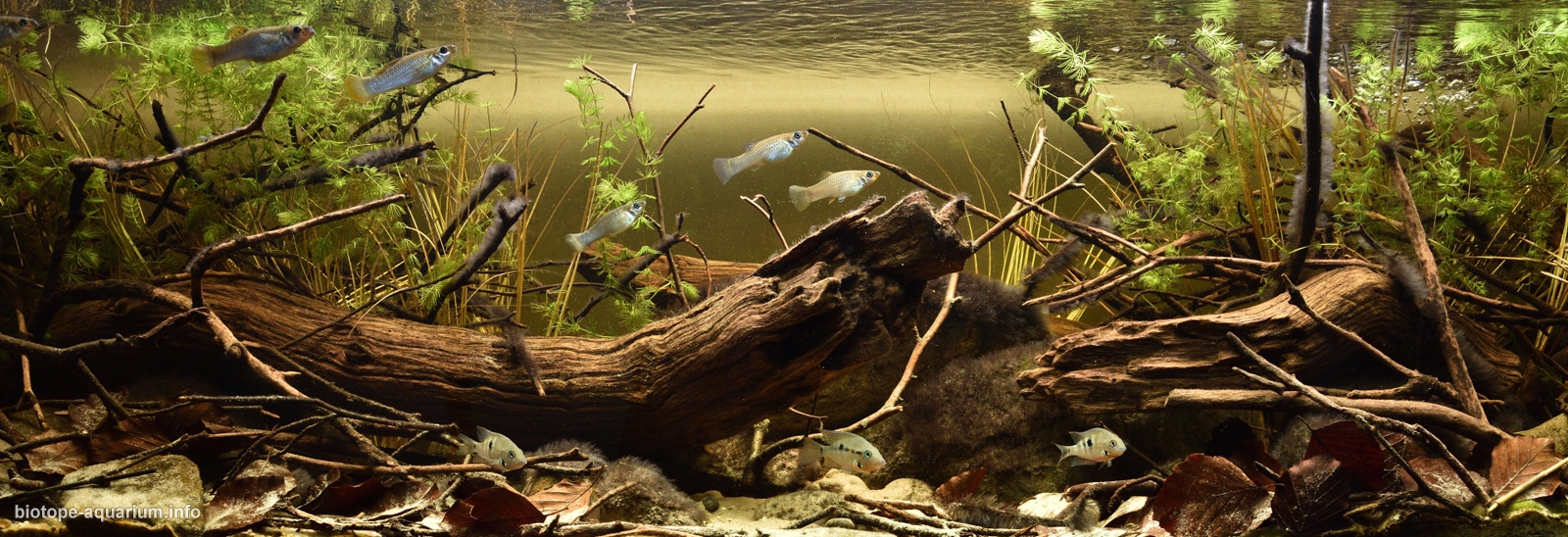Subin River, shallow grassy river bank area, Usumacinta drainage, Guatemala
8th place in Biotope Aquarium Design Contest 2018
![]() United Kingdom. Lee Nuttall
United Kingdom. Lee Nuttall

Volume: 375 L
Dimensions: 150x50x50 cm
List of fishes: Thorichthys meeki, Poecilia mexicana
List of plants: Myriophyllum sp.
Description of decorations: Sand mixed with beech tree leaves and twigs, small River boulders. Locally collected beech / oak tree branches and twigs. Replicate grasses to simulate yellowing underwater grass.
Description of equipment: EHEIM classic 600 with both biological and mechanical filtration, 1 x Arcadia T8 38W freshwater lamp, EHEIM thermocontrol 250 heater.
Water parameters: Temperature is 27°C, 80.6F, pH is 7.5, Ammonia is 0 ppm, Nitrite is 0 ppm, Nitrate is 20 ppm, GH is 18.
INFORMATION ABOUT BIOTOPE
Description of the area surrounding the biotope: The Subin River is a small affluent of de la Pasion River near Sayaxché in the Usumacinta river drainage Guatemala. GPS 16°38’13″N, 90°10’58″W. The La Pasión River flows through the western half of Petén. The drainage system of La Pasión River and its tributaries cover an area of 1,930 mi2 (5,000 km2), making it a major watershed in this region. Tributaries that begin in Alta Verapaz feed into the river, which eventually joins with the Salinas River to form the Usumacinta River and drain into the Gulf of Mexico. The river is also very biologically diverse – it has a record of 45 species of endemic fish and has nearly 300 species of endemic birds living near its borders. 150 medicinal plants can be found in the forests that grow alongside the river. The Subin River is mainly a jungle with open clearings. Some areas around the Sayaxché region have been cut down, however, the upstream areas of Subin is still well preserved.
Description of the underwater landscape of the biotope: The River flows through both jungle and open grassy areas, there are connecting faster flowing shallow rocky riffles which connect to pools which can be as deep as 4 meters. These pools can also contain lots of wood and the substrate is generally silted. River width varies from 40 meters to only 5 meters. There are lots of aquatic plants near the river bank such as Myriophyllum and columns of Vallisneria, also terrestrial overhanging grasses. Substrate is a mixture of sand silt with areas of leaf litter, especially through tree lined parts of the river. A lot of sediment can build up in these areas giving very low transparency levels of less than 1 meter. Generally transparency levels are up to 4 meters. My biotope is based around the tree lined River bank where there is submerged driftwood and lots of leaf litter, Myriophyllum with submerged grasses.
Description of the parameters of the habitat: I was unable to find any measurements available; however, due to the calcareous nature of rock formations in the rapid parts, water can be expected to be hard and alkaline.
List of fishes and invertebrates occurring in the nature biotope: Cichlids: Chuco intermedium, Petenia splendida, Oscura heterospila, Rheoheros lentiginosus, Thorichthys helleri, Thorichthys meeki, Trichromis slavini, Vieja melanura. Non cichlid (probably incomplete list): Astyanax aeneus , Carlhubbsia stuarti, Belonesox belizanus, Gambusia luma, Gambusia sexradiata, Heterandria attenuate, Poecilia mexicana, Xiphophorus hellerii.
List of plants found in the nature biotope: Myriophyllum, Nymphaea sp. and tall columns of Vallisneria near the shorelines.
Threats to the ecology: On June 6, 2015, residents around La Pasión River reported finding of a high count of dead fish floating along the river. Subsequent investigation found that the palm oil extracting company “Reforestadora de Palmas de Petén, S.A.” (REPSA), located in Sayaxché, found traces of Malathion in the company’s tributaries leading to La Pasión River. This was reported to be heavy rain which caused the treatment wells to flood into the river. The good news is that there are no direct threats to the Subin River. Locals use the River as a popular bathing place which causes lots of sediment and poor visibility in the river however, traveling to the upper parts people are generally avoided.
Sources of information:
Personal communication with Juan Miguel Artigas Azas
The Cichlid Room Companion
https://en.wikipedia.org/wiki/
Comments of the members of the jury of Biotope Aquarium Design Contest 2018

Another well executed meeki biotope. Grasses add a nice touch but I wonder will those be a problem when they start to decay. There is a lot of biological matter in the aquarium and the water has good hardness, so I believe you are taking good care of the aquarium. Fish are in good health and active. With all that and balanced layout, I give this aquarium high grades.

I’m not sure which one of Lee Nuttall’s Thoricthys meeki biotopes I prefer. But it’s nice to see different habitats and even different countries displayed with the same species. The Myriophyllum could look a little bit healthier, and there is a tiny bit of green algae on the front glass in the video. I believe the yellowing grasses are replica, so maybe some yellowing natural grasses (difficult I know,) would be better. Again, if Guatemalan tree species were used to provide the source of leaves it would help me to not identify the leaves used as British. And perhaps a little bit more maturity in the Thoricthys. Lee Nuttall is known for using beautifully mature Central American cichlids in his biotopes, so to see some larger, older Firemouths for me, would have been a real treat, and would take me back to those Firemouth images used in aquatic books of old.
In my opinion fishes in this tank breathe a little bit too fast – not sure what is the reason, too high temperature when filming was done, maybe? Except of this, the tank looks very good – a little bit “dirty” and mature, with beard algae having plenty of time to grow on wood and stones.

It is an aquarium with an interesting design, containing materials that are usually observed in the nature biotope, although very neat. As a recommendation I would add a bit of detritus on wood and substrate since in nature and in the rivers that I have explored, in the margins there is a remarkable accumulation of organic matter, as well as degraded. With it the effect in my opinion would be even more real. But in general it is a very good work. Good job!

I immediately recognized your work Lee. In this case this is good news. Excellent work, artistically and biotopewise. For me personally, this was your best work in this competition. Keep up the good job!
